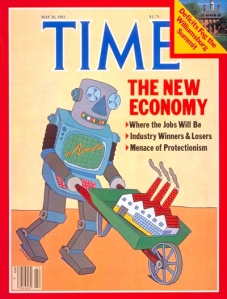Various ideas that have been floating around in my head over the past years came together recently in a rather dramatic “Ah-HA!” moment. It was like a mental vortex that was initially moving rather slowly, as a sluggish whirlpool, but then built up momentum until, in one moment of brilliant inspiration, it coalesced like a Big Bang into an idea that got me really excited.
This plan is based on several key ideas that I’ve been pondering for some time. First idea: mentorship. How much better it is to learn by doing then to be told how to do it. Second idea: adolescence. An artificial age construct that arose from the systematic infantalization of our youth; we keep them out of the adult world at a time when biology drives them to take on adult responsibilities and we wonder why they end up creating cultures of their own whose values sometimes clash with the adult world. Third idea: entrepreneurship. Peter Thiel offers a scholarship to college students that pays them to drop out and start a business. His premise is that you get a far better education by starting up, and even failing, a few businesses over the course of a typical college education than you do going into debt for a degree. Fourth idea: the propaganda fed to parents and students that college is the only route to success. This combines with the Fifth idea, which is that university degrees are rapidly losing their value and we should stop using them as a tickets to a job.
All these ideas came together one morning while I was lying in bed, thinking about my daughter who, at age 11, is getting close to that time when she will need to start thinking about what direction to follow in terms of her working life. Given that she doesn’t go to school, she has plenty of time to start her own business, do an internship or two, attend some non-credit college courses, or mentor under somebody she admires in a field of interest to her. I thought about all the poor schmucks in high school who have to wait until graduation to fully enjoy such experiences (and then figure out how to support themselves while doing so), and I suddenly wondered what would happen if we just got rid of high school altogether and, instead, replaced it with real experiences at real jobs. Here is what I came up with:
For the first 12 – 13 years a child would be educated in a child-led learning environment whose main goal is to allow children the intellectual freedom to discover their passions and interests, what Sir Ken Robinson referred to as The Element.
Around the age of 12-13, kids would leave this learning environment and be assigned an unpaid internship at a real business in their community. At first, they might work 3 hours a day, four or five days a week, leaving them plenty of time for extracurricular activities and, later, part-time paid employment. As the kids got older they would work longer hours until, by the time they reached 18 or so, they would be working full time.
Employers would receive significant government incentives to hire such interns (from all the money we’ve saved by not having high schools anymore), and because interns are unpaid, their costs to the employer are virtually nil. When I think of my own smallish community of about 5,000 in town and 30,000 in the surrounding area, I can list dozens of business and industries right off the top of my head: libraries, fish farms, logging and forestry, pulp mills, lawyers, doctors, dentists, city council, civic and mechanical engineering, hair salon and spa, bakery, restaurant, farmers, dog trainers, horse trainers, couriers, bookstores, health and fitness, grocery stores, software development, tech support, pharmacists, car mechanics, butcher, well and irrigation specialists, landscapers, house cleaning businesses, livestock hauling, construction and trades (plumbers, electricians, carpenters, roofers, painters)….the list goes on. And lest you think the idea of an internship in a hair salon or gas station, for example, means just training a kid to cut hair or pump gas, think bigger: learning to run a small business (keeping the books, ordering supplies, calculating costs and profits, managing employees, etc.).
As part of the requirements for employers to get their government incentives, the interns would have to be in training, not gophers who are taken advantage of to do the tasks that nobody else wants to do. This is where the Career Consultant comes in.
Each child (intern) would be assigned a Career Consultant (CC), paid for by government using money formerly allotted to high school education. Each career consultant would handle only a few interns so that they could retain a personal relationship with each one. Their job is to be the intern’s advocate. They check in with the student weekly or bi-monthly, serve as a liaison between intern and employer, ensure that these unpaid interns are not being taken advantage of by employers, guide the intern toward the areas of work that interest him/her, and generally follow along with the student through the next five or six years until they complete the program. Ideally, the CC stays with one student throughout the course of the program to really personalize each child’s experience. This can all be done through electronic communication with some site visits. With the guidance of their CC, kids can figure out what jobs appeal to them and then focus on internships in that industry to gain job-specific skills and experience. And, of course, to network and build relationships, which are oh-so-important for getting a paid job.
An intern can request placement in a particular job if they already have an idea of what they want to do, but kids who don’t know what they’d like to do would be assigned an internship somewhere in the community by the CC, based on the CC’s knowledge of the intern (through a thorough interview process and get-to-know-you period that, ideally, starts in the last months before entering the internship program). There would be a minimum time commitment of, say, 3 months before an intern can request a transfer, and internships would end after 6 months. If the intern liked the position they could stay as long as they wanted or maybe be moved to a different employer in the same field (my concern would be ensuring equal opportunity for all students to try out all fields). If the employer wasn’t happy with the intern’s performance, and if the CC could not help resolve this issue, the employer would have the right to terminate the internship and the intern would be placed elsewhere. If certain internships are really popular and can’t take on all the kids who want to work there, shorter terms and rotations could be arranged, but consider that employers can take on as many interns as they have employees to mentor them, so hopefully this wouldn’t be a huge issue.
There is no competition for placement. You cannot get it based on grades, or marks assigned by employers, or by collecting any form of “currency” that gives you an advantage over other students. The intern’s performance is shared only with the CC and not with any other employers. This serves many functions. First, the current climate of high school students following gruelling schedules of work, school, and volunteer time simply to qualify for college entry is ruining their lives. In my day, I had a B+ average and plenty of time for a life outside high school, and I got into university with no problem. Today’s kids are overscheduled and stressed-out because their entire life is geared towards beating out the thousands of other kids all competing for the same few spots in college. That is no way to live, and the minimum standards for college entry bear no correlation with the ability to be successful in college (and life beyond) anyway. Second, it keeps the playing field even, especially for kids in lower socioeconomic groups. Third, it allows kids to make mistakes and not be penalized by them for life. It may take some kids a while to learn good work ethics, or to figure out why they are not performing to the employer’s standards. The CC’s job is to help them with this and get them into another internship so they can try again with a fresh clean slate. In short, in my scenario, there is no reason for kids to get all competitive and try to gain advantages over their peers. It’s an equal opportunity playing field.
But what about the “fun” things that school provides, like sports teams, academic and hobby clubs, art education, and all those other things that, frankly, many schools have already dispensed with due to lack of funding? And, let’s be honest, schools also serve a major function as government-sponsored daycare centres. What do kids do outside of their internship hours? My idea includes using some of the aforementioned government savings on education to fund community centres. Each community would have a proper recreation/community centre/library complex that would offer such programs at minimal-to-no cost to students. Sports, art classes, club meetings, and other “extracurricular” pursuits could take place there, and it would provide a hangout for those kids who, for whatever reason, can’t go home after working at their internship (remember it isn’t full-time until the last year or so of the program).
There are numerous benefits to implementing such a plan, not just for students but for communities as a whole.
(1) This program gets rid of arbitrarily-designed curricula, useless busywork in the form of essays and homework assignments, and irrelevant, out-of-context, factoids that schools spend so much time and money trying to get kids to memorize long enough to regurgitate onto a test paper. As interns, kids would learn valuable interpersonal skills such as time management, conflict resolution, and other things that are so important when working in a business or industry with people from varying ages, backgrounds, levels of authority, etc. I don’t think school, with its age-segregation and overly-bureaucratized rule structure, fully prepares kids for this reality.
(2) More importantly, by the time kids have completed the program they have a portfolio, rather than a “report card,” which reflects nothing useful for the working world, unless you happen to land a job in an industry that consists of taking multiple-choice quizzes and writing essays on random topics. By the end of their internship, kids will have worked at a series of jobs over the last 5 or 6 years and that, my friends, is Real Life experience. Along the way they have picked up many skills, both technical and manual. They have likely figured out what job or industry appeals to them and, having focused on that industry during the last few terms or years of their internship, have now made connections in the business, have references, have accumulated the necessary skill sets, and have a solid understanding of how that business or industry runs. When they go to get a full time paid job in the industry in which they have already been participating, they don’t need to present their grade point average or report card or score on a provincial standardized test because they would have real, documented evidence of their skills. This could be projects on which they worked, products they helped design and take to market, and any other documentable task. Not to mention, at this point they would be allowed to gather references from any and all former employers who worked with them as interns. If you were hiring someone for a job in your industry, which would you rather take, the kid who has been holed-up in a high school for the last five years, has an excellent grade-point average, but little-to-no real experience with holding down a job, working for and with people, and doing pretty much anything in your industry? Or, the kid who has spent the last 3 years interning with your colleagues and peers in industry, who has real outcomes to show from real people in real businesses doing real work, and who can be judged on actual performance in the field. I know who I would choose.
(3) Youth would be integrated into the community, rather than warehoused and isolated from it. What better way to get youth involved in their community than by allowing them to be active participants in it? This giving of responsibility to kids who are old enough to handle it and who are biologically driven to seek it could possibly end the increasingly toxic social consequences of age-segregation and ridiculously low adult:child ratios, such as bullying and cliques. Not to mention the also-toxic consequences of boredom and exclusion from adult society and responsibilities, such as substance abuse, vandalism, and excessive risk-taking.
(4) It’s not just the students who benefit, but the entire community. The aforementioned community centre/library/recreation centre complexes that take the place of high school buildings would serve Everybody in the community, not just high school kids, and many more programs could be run than just those for the kids. Most communities already have such facilities in place, but for many they are badly in need of upgrading and enhancement. Smaller towns that currently lack such facilities would hugely benefit by having the funds to build one. So immediately this program would benefit communities for everybody in them, and no more battles around how best to use taxpayer money for schools.
(5) Workers would benefit by having a second set of hands to help them with their jobs and by getting mentorship training (perhaps provided as part of those government incentives I spoke of earlier). If every working person in a community had a student intern, it would ease the work load on everyone and free up more time for other pursuits. Think of the community building that could take place if people had some extra leisure time.
(6) The interns would need a transportation system to get them to and from their internships, home, and the community centre as most can’t drive and/or don’t have cars. Communities could put some of the money they save by not having high schools and school buses into boosting transportation infrastructure so that the interns can get to and from their jobs and their after-job activities. Governments could subsidize or pay for student bus/transit passes which would provide a monetary boost to cash-strapped municipal transit systems. Whether it’s a shuttle bus system in a small town or subway passes in a larger town, the adding of the entire population of high school students to the transportation ridership would definitely provide a much needed boost to their bottom line. For smaller towns and rural communities, which often lack decent transit systems due to low ridership, it would be enough to make it worth their while to invest in transportation which, again, would serve EVERYBODY in the community, not just high school kids.
So that is the basic outline of my idea. In Part 2, I’m going to present an example of what this would look like using two hypothetical kids.










